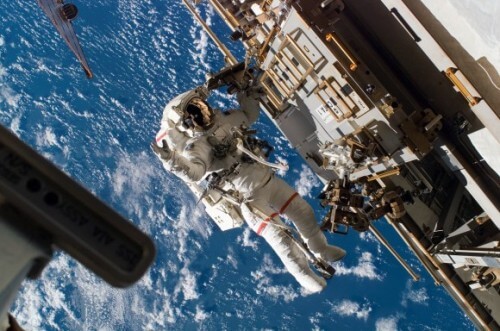The series of spacewalks to be performed by two American astronauts is intended to repair the cooling loop that broke down about a week ago and caused the shutdown of scientific experiments and non-essential systems on the International Space Station

When NASA astronaut Mike Hopkins goes into space for the first time this week, he will wear the spacesuit that has been disabled until now because of the water leak that forced Italian astronaut Luca Parimitano to return to the station last July. This is what NASA said this week (December 18, 2013).
Although at first glance it sounds like added drama to Hopkins and Rick Mastrazio's unplanned mission on December 21,23, 25 and XNUMX to repair the station's broken cooling loop, the astronauts, under the supervision of ground crews, made some changes to it that were designed for reuse.
In accordance with NASA's directive, a new pad was added to the back of all American helmets, with the aim of absorbing the water in the event of a repeated leak. The astronauts will also attach a tube with velcro - which in case of emergency will flow the water to the place where the air that the astronauts exhale is flowed.
Also, the members of the 38th team replaced the pump strainer, which is most likely the component that caused the leak that caused the water to enter the helmet.
Finally, new procedures were established whereby the astronauts themselves would monitor the surface of their helmets and warn of liquids. NASA has also changed spacewalk procedures, increasing the use of the station's Canadian robotic arm to make sure the airlock is always within astronauts' reach.
As mentioned, this is an unplanned series of repairs after about a week ago (December 11), the internal flow control valve of the pump located outside the station stopped regulating the ammonia temperatures in an external cooling loop. The loop is intended, as the name implies, to cool the electronic systems in the space station. If the loop has become too cold it closes automatically.
NASA stopped scientific experiments and turned off non-essential systems. Experiments in the American Columbus module and the Japanese module were hampered after NASA failed to activate the heat exchanger in the station's No. 2 node.
After it was determined that repairs were needed, such as replacing a valve that regulates the flow of ammonia upstream, NASA decided to replace the entire system. The need for cooling is particularly important because the space station is also now in the annual period known as 'high beta', when its orbital dynamics cause the sun to shine on it for longer periods than usual.
Left with no choice, NASA decided to carry out the replacement in a series of three spacewalks during the coming week. During the first spacewalk, the pump with the broken valve will be disconnected and the replacement pump will be brought to the vicinity using the robotic arm.
During the second spacewalk, the damaged pump will be removed and the replacement pump will be partially installed (without the screws and electrical connections). During the third spacewalk, the installation of the spare pump and the storage of the faulty pump outside the station will be completed. NASA believes that they will be able to return to using it if the astronauts install a new valve on it, but another vision for the time being.
According to the results of the repairs, NASA will decide whether to approve the flight of Orbital Sciences' Cygnus cargo spacecraft.
By the way, the faulty pump is only three years old - in 2010, astronauts had to perform three spacewalks to install it after a more serious malfunction. NASA defines this situation as an unusual failure and said that this is not a symptom of the aging of the space station.
